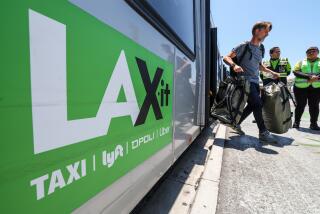Shooting Forces Scrutiny of Airportsâ Open-Door Policy
The fatal Independence Day shooting at Los Angeles International Airport highlights just how difficult it is to protect people who use the nationâs airports from random acts of violence.
Even with the heightened security in place since the Sept. 11 terrorist attacks, there is nothing to prevent someone carrying a weapon from walking into one of the nationâs 429 commercial airports, which are essentially public places like shopping malls or grocery stores.
Hesham Mohamed Hadayet, the gunman in Thursdayâs incident, carried three weapons--a 9-millimeter handgun, a .45-caliber semiautomatic Glock pistol and a six-inch hunting knife. He had extra ammunition and magazines ready to go, the FBI said Friday.
Officials said itâs likely the carnage would have been even worse if the suspect had been at any airport ticket counter other than the one occupied by El Al Israel Airlines, where armed guards are present at all times. Three were killed in the shooting in the Tom Bradley International Terminal, including the suspect, and three were wounded.
Protecting airports against such incidents in the future wonât be easy. New federal aviation security laws donât provide for additional security at airport ticket counters or baggage claim areas. And most airports arenât designed to move security checkpoints closer to the front door.
Even so, Mayor James K. Hahn said Friday that the shooting reinforced his plans to increase security at LAX, a tenet he emphasizes in the $9.6-billion modernization plan he unveiled at the airport earlier this week.
In preparing his plan, Hahn said he met with a former head of security for El Al--known worldwide for its strict security procedures--who convinced the mayor that LAX needs stronger security measures.
âThey want a failsafe, zero-tolerance system; they donât accept anything else,â Hahn said in an interview. âI donât think we can bury our heads in the sand anymore. I think we need to go to the El Al level of security.â
The mayor added that his staff is going to consider moving the screening of passengers and baggage farther away from airport terminals. In Hahnâs plan, passengers and their luggage would still travel through security at the terminals.
Nationwide, Thursdayâs shooting abruptly shifted the discussion about aviation security away from airplanes and toward how airports can better protect their facilities.
âTo protect the airport itself, one has to decide where you draw the security line,â said Brian Jenkins, a senior advisor to the president of the Rand Corp. and a former member of the White House Commission on Aviation and Security. âAn airport is a city--it has thousands of people working in it, and tens of thousands of people constantly passing through it.â
Some Middle Eastern airports--including facilities in Jordan, the United Arab Emirates, India and Pakistan--screen passengers and baggage well before the ticket counter. But moving bulky magnetometers and X-ray machines closer to terminal doors wonât work at most major U.S. airports--which, in most cases, were designed before a spate of hijackings prompted the installation of security equipment in the early 1970s.
The Transportation Security Administration, which has jurisdiction over passenger and baggage screening at the nationâs airports, said Friday that it doesnât plan to move security checkpoints closer to terminal doors.
In addition, the traveling public and the airlines, which are loath to compromise passenger convenience, arenât likely to support moving passenger checkpoints.
âAirports in many cases are large commercial shopping centers,â said Billie H. Vincent, a former head of security for the Federal Aviation Administration. âOne would be restricting the terminal to passengers only, and that would considerably reduce the amount of sales in the process.â
The TSA, however, is working with airport officials and local police agencies to increase the presence of law enforcement in airports, said Deirdre OâSullivan, a TSA spokeswoman.
Instead of moving security checkpoints, U.S. airport officials could adopt a system used at Middle Eastern airports that relies on âconcentric circlesâ to provide security for passengers, experts said.
That would include security that starts at the airport entrance and continues inside the facility with plainclothes and uniformed officers, said Jeff Schlanger, chief operating officer of the security services group at Kroll Inc. in New York.
There are several other steps airports can take to protect against random violence, experts said, including moving passengers through security checkpoints faster to reduce casualties should an incident occur in a ticket lobby or baggage claim area. An increased number of security personnel and closed-circuit cameras also might help deter criminals, said Jenkins, the Rand Corp. advisor.
The Los Angeles Police Department did increase its presence at LAX after Thursdayâs incident and plans to keep additional officers and squad cars at the airport throughout the holiday weekend.
Security at LAX is carried out by an amalgam of agencies, including the airport police, the LAPD, the TSA, the FBI and the FAA. The agencies have drawn up agreements about which has jurisdiction during certain events. The airport police typically try to prevent incidents, while the LAPD primarily responds when a crime occurs at the 3,500-acre facility.
The FBI took charge of Thursdayâs investigation because of the possibility that terrorism was involved. Airport police and the LAPD provided perimeter security and crowd control.
Questions arose Friday about whether this complex security structure contributed to the chaos at the nationâs third-busiest airport following the shooting.
Airport officials agreed that the incident looked messy and inconvenienced thousands for hours, as did other highly publicized airport evacuations around the country after Sept. 11.
But they added that the agencies charged with providing security at LAX donât have the resources to baby-sit stranded passengers.
âWe have thousands of people to deal with, and the path never turns off--people are constantly arriving at the airport,â said Bernard J. Wilson, the chief of airport police. âThe reality is law enforcement agencies donât have the resources to go around and give everyone updates.â
Though many agreed the coordination among the various agencies went well on Thursday, the incident brought to the surface a long-standing rivalry between the airport police and the LAPD. Numerous attempts have been made to consolidate the forces--including one by former Los Angeles Police Chief Bernard C. Parks, which was rejected by the City Council in 1998.
The airport police department was established in 1946, and given full authority over the airport in 1968.
But some said Friday that having two police departments at the airport is inefficient. Police Commission President Rick Caruso said the incident made him believe more strongly that the LAPD should handle all LAX security.
âThe LAPD has a lot of expertise, and itâs gaining more in dealing with anti-terrorism,â Caruso said. âI think there should be one integrated force thatâs sharing the information and the expertise and are trained with the same standards.â
Hahn said he does not believe the airport police and the LAPD should be consolidated.
âI think itâs valuable to have both agencies out there,â Hahn said. âAs far as Iâm concerned, I donât know if itâs necessary.â
But he acknowledged that some city officials are discussing the possibility.
Voters would have to approve an amendment to the City Charter before the LAPD could take control of the airport police, according to the new charter adopted in 2000.
*
Times staff writers Jailan Zayan in Cairo; Bill Lobdell, Mai Tran and Daniel Yi in Orange County; Eric Lichtblau and Josh Meyer in Washington; and Andrew Blankstein, Daren Briscoe, David Colker, Rich Connell, Jessica Garrison, Carla Hall, Erika Hayasaki, Duke Helfand, Greg Krikorian, Mitchell Landsberg, Kurt Streeter and Rebecca Trounson in Los Angeles contributed to these reports.
More to Read
Sign up for Essential California
The most important California stories and recommendations in your inbox every morning.
You may occasionally receive promotional content from the Los Angeles Times.










